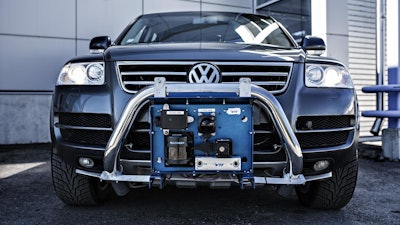
Marilyn, the first automated car to be granted a road traffic testing permit in Finland, and its spouse Martti have taken things to a new level together and started exchanging information with each other and their driving environment. They will take the next step in their relationship in the autumn, when the public digital infrastructure can also talk with the couple (view photos in gallery).
The automated cars developed by VTT Technical Research Center of Finland can hear, see and sense, and Finnish intelligence hums in their brains. They are able to follow a pre-programmed route and avoid collisions with sudden obstacles without input from the driver. The cars currently require the lane markings or sides of the road to be visible. This is, however, only the first step; by 2020, the cars will be driving in more demanding conditions on roads covered in gravel and snow.
"Our cars already have enough equipment required for automated driving, and now we are taking the most out of them with software technology. The challenges range from small to big ones, but that's fascinating," says project manager Matti Kutila from VTT.
The autonomous cars feature a thermal camera for observing people and animals; a stereo camera and radar for high-resolution scanning of the vicinity; laser scanners and long-range radars for seeing farther; and GPS/Glonass receivers for positioning.
The cars also have inertia units for determining direction and accelerations. The actuators are cylinders and motors. The sensors and actuators are connected by intelligence that creates a situational awareness and controls the actuators so that the car moves as planned at an accuracy of milliseconds and centimeters.
"The communications channel of the automated cars is open, but the messages are not yet fully compliant with the standards. Come autumn, the cars will exchange information in a standard format, also allowing others to talk with them," says Kutila.
Big Things By 2021
According to Kutila, the next step for VTT's automated cars will be changing the wavelengths of the optical components, increasing the resolution of the radar, and building more intelligence in the software monitoring the capabilities of the sensors. These are intended to do their part in tackling demanding weather conditions such as a slippery road surface, concealed edge of the road or fog.
Different scenarios are added step by step in the development of the autonomous cars (such as cities, main roads, snow, exit ramps) that the car can manage, while increasing the driving speed and managing difficult driving conditions with improved intelligence.
"Today, the automation of traffic is generally speaking just taking its first steps - the big things will not come until 2021 and later. This is a kind of a 'never ending story'. It is certain that the number of code lines in cars will grow explosively in the coming years - today, we are talking about maybe 3,000 lines in our cases," says Kutila.
Autonomy will also be introduced into lorries and buses and even ships, but in a different form. Working machines, however, are marching in the front lines of the development of autonomy. Their working areas can be limited, which makes autonomous operation easier. In traffic, creating such limits is not as easy.
Safety and cybersecurity threats will be increasingly involved when the IoT for vehicles, or Internet of Things, and information networks advance. A lot of work is still required to develop a car that operates completely reliably and observes its environment.
"What the cars have today has not been built in six months; it is a result of over 20 years of work," says Kutila.






















